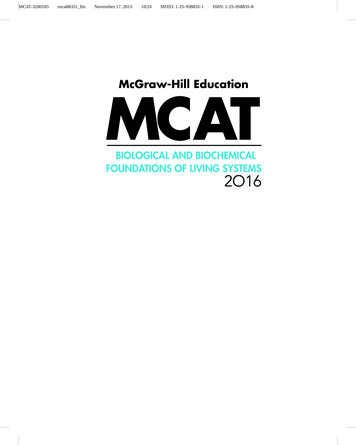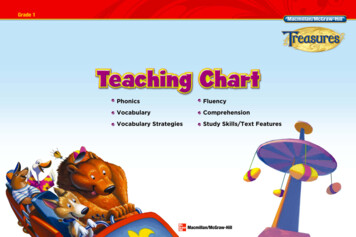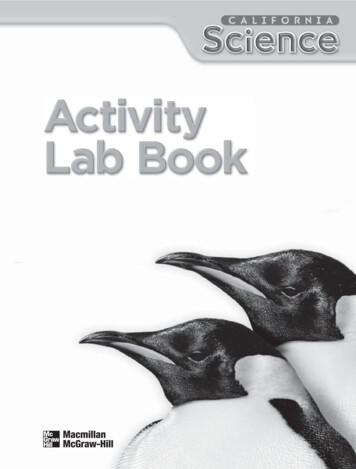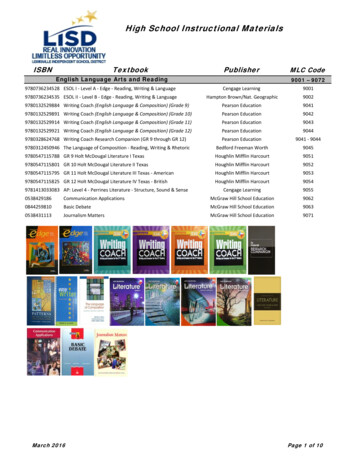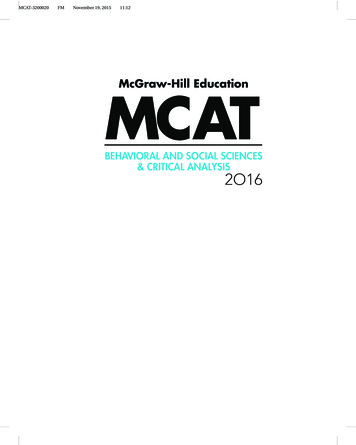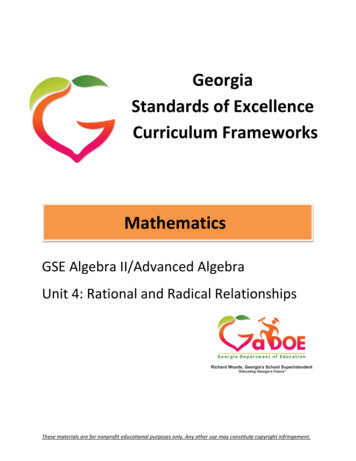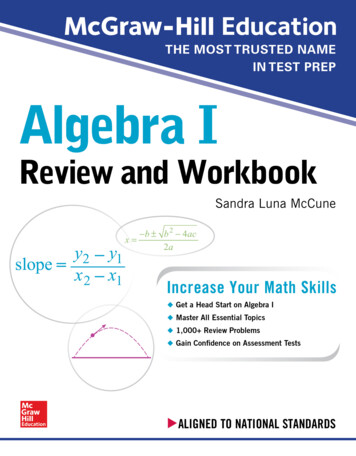
Transcription
Algebra IReview and WorkbookSandra Luna McCune, PhDNew York Chicago San Francisco Athens London MadridMexico City Milan New Delhi Singapore Sydney TorontoFM.indd 116-11-2018 16:11:06
Copyright 2019 by McGraw-Hill Education. All rights reserved. Except as permitted under the United States Copyright Act of 1976,no part of this publication may be reproduced or distributed in any form or by any means, or stored in a database or retrieval system,without the prior written permission of the publisher.ISBN: 978-1-26-012895-6MHID:1-26-012895-4The material in this eBook also appears in the print version of this title: ISBN: 978-1-26-012894-9,MHID: 1-26-012894-6.eBook conversion by codeMantraVersion 1.0All trademarks are trademarks of their respective owners. Rather than put a trademark symbol after every occurrence of a trademarkedname, we use names in an editorial fashion only, and to the benefit of the trademark owner, with no intention of infringement of thetrademark. Where such designations appear in this book, they have been printed with initial caps.McGraw-Hill Education eBooks are available at special quantity discounts to use as premiums and sales promotions or for use in corporate training programs. To contact a representative, please visit the Contact Us page at www.mhprofessional.com.TERMS OF USEThis is a copyrighted work and McGraw-Hill Education and its licensors reserve all rights in and to the work. Use of this work is subjectto these terms. Except as permitted under the Copyright Act of 1976 and the right to store and retrieve one copy of the work, you maynot decompile, disassemble, reverse engineer, reproduce, modify, create derivative works based upon, transmit, distribute, disseminate,sell, publish or sublicense the work or any part of it without McGraw-Hill Education’s prior consent. You may use the work for yourown noncommercial and personal use; any other use of the work is strictly prohibited. Your right to use the work may be terminated ifyou fail to comply with these terms.THE WORK IS PROVIDED “AS IS.” McGRAW-HILL EDUCATION AND ITS LICENSORS MAKE NO GUARANTEES OR WARRANTIES AS TO THE ACCURACY, ADEQUACY OR COMPLETENESS OF OR RESULTS TO BE OBTAINED FROM USINGTHE WORK, INCLUDING ANY INFORMATION THAT CAN BE ACCESSED THROUGH THE WORK VIA HYPERLINK OROTHERWISE, AND EXPRESSLY DISCLAIM ANY WARRANTY, EXPRESS OR IMPLIED, INCLUDING BUT NOT LIMITEDTO IMPLIED WARRANTIES OF MERCHANTABILITY OR FITNESS FOR A PARTICULAR PURPOSE. McGraw-Hill Educationand its licensors do not warrant or guarantee that the functions contained in the work will meet your requirements or that its operation will be uninterrupted or error free. Neither McGraw-Hill Education nor its licensors shall be liable to you or anyone else for anyinaccuracy, error or omission, regardless of cause, in the work or for any damages resulting therefrom. McGraw-Hill Education has noresponsibility for the content of any information accessed through the work. Under no circumstances shall McGraw-Hill Education and/or its licensors be liable for any indirect, incidental, special, punitive, consequential or similar damages that result from the use of orinability to use the work, even if any of them has been advised of the possibility of such damages. This limitation of liability shall applyto any claim or cause whatsoever whether such claim or cause arises in contract, tort or otherwise.
ContentsChapter 1Understanding the Real Numbers1Classifying Real Numbers1Rational and Irrational Roots2Properties of the Real Numbers5Chapter 2Commutative and Associative Properties5Identity and Inverse Properties6Distributive Property8Zero Factor Property9Chapter 3The Number Line and ComparingNumbers11The Number Line11Comparing Numbers12Chapter 4Absolute Value13Determining Absolute Value13Properties of Absolute Value14iiiFM.indd 316-11-2018 16:11:07
iv ContentsChapter 521Performing Operations with RealNumbers(Algebraic) Addition and Subtraction of Real Numbers17(Algebraic) Multiplication and Division Rules forReal (Signed) Numbers19Chapter 621Exponents21Positive Integer Exponents21Zero and Negative Integer Exponents22Rules for Negative Exponents23Unit Fraction and Rational Exponents24Rules for Exponents26Chapter 729Radicals29Expressing Rational Exponents as Radicals29Product and Quotient Rules for Radicals30Transforming Radicals into Simplified Form31Chapter 833Order of Operations33Grouping Symbols33Order of Operations34Chapter 937Algebraic Expressions and FormulasFM.indd 41737Algebraic Expressions37Formulas3916-11-2018 16:11:07
ContentsChapter 1041Polynomial Terminology41Monomials41One-Variable Polynomials43Chapter 1145Adding and Subtracting Polynomials45Adding and Subtracting Monomials45Adding and Subtracting Polynomials46Chapter 1249Multiplying Polynomials49Multiplying Monomials49Multiplying a Polynomial by a Monomial50Multiplying Binomials51Multiplying Two Polynomials53Special Products54Chapter 1357Simplifying Polynomial Expressions57Removing Parentheses by Additionor Subtraction57Removing Parentheses by Multiplicationor Raising to a Power58Chapter 1459Dividing PolynomialsFM.indd 5 v59Dividing a Polynomial by a Monomial59Dividing a Polynomial by a Polynomial6016-11-2018 16:11:07
vi ContentsChapter 1565Factoring PolynomialsFactoring Out the Greatest Common Factor65Factoring the Difference of Two Squares66Factoring Perfect Trinomial Squares67Factoring the Sum and the Difference of Two Cubes68Factoring General Trinomials68Chapter 1671Fundamental Concepts ofRational Expressions71Definition of a Rational Expression71Reducing Rational Expressions72Building Up the Denominator of a Rational Expression74Chapter 1777Multiplying and DividingRational Expressions77Multiplying Rational Expressions77Dividing Rational Expressions78Chapter 1881Adding and SubtractingRational ExpressionsFM.indd 66581Adding and Subtracting Rational Expressions, LikeDenominators81Adding and Subtracting Rational Expressions, UnlikeDenominators8216-11-2018 16:11:07
ContentsChapter 1985Simplifying Complex Fractions85Writing Complex Fractions as Division Problemsto Simplify85Using the LCD to Simplify a Complex Fraction86Chapter 2089One-Variable Linear Equationsand Inequalities89Basic Concepts89Solving One-Variable Linear Equations90Solving Linear Equations with Two or More Variablesfor a Specific Variable94Solving One-Variable Linear Inequalities95Chapter 2197One-Variable Quadratic Equations97Basic Concepts97Solving Quadratic Equations of the Formax2 c 098Solving Quadratic Equations by Factoring100Solving Quadratic Equations by Completing theSquare101Solving Quadratic Equations by Using theQuadratic Formula103Chapter 22105The Cartesian Coordinate PlaneFM.indd 7 vii105The Coordinate Plane and Ordered Pairs105Quadrants of the Coordinate Plane10816-11-2018 16:11:07
viii ContentsChapter 23111Formulas for the Coordinate PlaneDistance Formula111Midpoint Formula113Slope Formula114Rise and Run114Chapter 24119Graphing Lines in the Plane119Graphing y mx b119Graphing Ax By C122Chapter 25125Determining the Equation of a Line125Determining the Equation of a Line Given theSlope and y-Intercept125Determining the Equation of a Line Given theSlope and One Point on the Line126Determining the Equation of a Line GivenTwo Distinct Points on the Line128Chapter 2 6131Signal Words and PhrasesFM.indd 8111131Common Signal Words and Phrases for Addition131Common Signal Words and Phrases for Subtraction132Common Signal Words and Phrases for Multiplication134Common Signal Words and Phrases for Division135Common Signal Words and Phrases for Equality13616-11-2018 16:11:07
ContentsChapter 27139Applying Algebra to Word Problems139Steps in Algebraic Problem-Solving139Be Careful with Units142Chapter 28143Applications143Number Problems143Age Problems146Ratio and Proportion Problems147Mixture Problems150Coin Problems152Rate-Time-Distance Problems153Work Problems156Percentage Problems158Simple Interest Problems160Geometry Problems162Chapter 29165Introduction to Functions165Defining a Function165Evaluating Functions167Chapter 3 0171Graphs of FunctionsFM.indd 9 ix171Vertical Line Test171Zeros and Intercepts173Increasing, Decreasing, and Constant Behavior17516-11-2018 16:11:07
x ContentsChapter 31185Common Functions and Their Graphs185Linear Functions185Quadratic Functions188Exponential Functions193Chapter 32195Introduction to Systems of Two-VariableEquations195Definition and Terminology for Systems ofTwo-Variable Linear Equations195Types of Solutions for Systems ofTwo-Variable Linear Equations197Chapter 33199Solving Systems of Two-Variable LinearEquations199Solving Systems of Two-Variable Linear Equationsby Substitution199Solving Systems of Two-Variable Linear Equationsby Elimination201Solving Systems of Two-Variable Linear Equationsby Graphing203Chapter 34207Graphing Systems of Two-VariableInequalitiesFM.indd 10207Graphing Two-Variable Linear Inequalities207Graphing Two-Variable Quadratic Inequalities20916-11-2018 16:11:07
Contents xiAppendix AMeasurement Units andConversionsAppendix b215Geometry FormulasAnswer KeyFM.indd 11213215Triangle215Right rcle216Trapezoid216Sphere216Right Prism217Right Rectangular Prism217Cube217Right Circular Cylinder217Right Pyramid217Right Circular Cone21821916-11-2018 16:11:07
This page intentionally left blankFM.indd 1216-11-2018 16:11:07
Chapter 1Understanding theReal NumbersClassifying Real NumbersEXAM PLEThe real numbers consist of the rational numbers and the irrational numbers.A rational number is a number that can be expressed as a quotient of an integerdivided by a nonzero integer. (The integers are the numbers , -3, -2, -1, 0,1, 2, 3, .) The decimal representations of rational numbers terminate or repeat.The irrational numbers are numbers that cannot be expressed as the quotientof two integers. Their decimal representations neither terminate nor repeat.Frequently, real numbers are called signed numbers because they are positive,negative, or zero.XX5.12 Rational number2 Rational number51XX1 Rational number2XX0.333 Rational numberXX-XX0.14 Rational numberXX6.020020002 Irrational numberXXp Irrational numberThe three dotsindicate that thepattern continuesin the same mannerwithout end.The bar above “14”means that a blockof digits continuesto repeat withoutend.The number p isthe ratio of thecircumferenceof a circle to itsdiameter.1ch01.indd 116-11-2018 10:07:05
2 McGraw-Hill Education Algebra I Review and WorkbookExercise 1.1Identify the real number as either rational or irrational.342. 011. -p1.12. 0.0253. 0.34. -9.2225. 56. 0.454554555 1077. 38. 0.111.9. 100.121212 10. -9.2313. -0.333.14. 101, 001, 00015. 0.010010001 16.5313218. 1319. 0.454545 920. 417. -Rational and Irrational RootsIf n is a positive integer, an nth root of x is a number that when used as afactor n times gives x, the number’s nth power. The notation n x is a radical.It indicates an nth root of the number x. The number n is the index, andx is the radicand. If n is a positive even integer and x is positive, then n xindicates the positive real nth root of x. (Even roots of negative numbers arenot real numbers.) If n is a positive odd integer and x is any real number, thennx indicates the real nth root of x. A number that is an exact nth power ofanother number is a perfect nth power. Roots of perfect nth powers are rationalnumbers, while roots that cannot be determined exactly are irrational numbers.Decimal representations of irrational numbers are given as approximations. Forexample, 2 1.414.EXAM PLEA letter that isused to representa number is avariable.XX3 Irrational because 3 is not a perfect square.XX3-8 Rational because 3 -8 -2.XX-ch01.indd 236 Rational because - 36 -6.XX420 Irrational because 20 is not a perfect 4th power.XX4-16 Not a real number.16-11-2018 10:07:15
Understanding the Real Numbers 3Exercise 1.2Identify the root as either rational, irrational, or not real. Justify your answer.1.2.3512.0.25813.9443.4. - 45.-46.167.31258.3-1259.41210.53211. 5 -32ch01.indd 314.36415. 1005316.17.3-1318. - 62519.6-6420.37516-11-2018 10:07:22
This page intentionally left blankch01.indd 416-11-2018 10:07:22
Chapter 2Properties of theReal NumbersCommutative and Associative PropertiesCommutative Property of Addition When you add two numbers, youcan reverse the order of the numbers without changing the sum.EXAM PLECommutative Property of Multiplication When you multiply twonumbers, you can reverse the order of the numbers without changing theproduct.XX6 4 4 6XX5.8 2. 1 2. 1 5. 8XX3 8 8 3 1 1 XX (10) (10) 2 2 Associative Property of Addition When you have three numbers toadd together, the final sum will be the same regardless of the way yougroup the numbers (two at a time) to perform the addition.Generally, inalgebra, do not usethe times symbol( ) to indicatemultiplication.Instead, fornumericalquantities, useparentheses orthe raised dotmultiplicationsymbol ( ).Associative Property of Multiplication When you have three numbersto multiply together, the final product will be the same regardless of theway you group the numbers (two at a time) to perform the multiplication.5ch02.indd 516-11-2018 10:26:49
McGraw-Hill Education Algebra I Review and WorkbookEXAM PLE6XX(4.9 0.1) 3.5 4.9 (0.1 3.5)XX(3 10) 1 1 3 10 22 Exercise 2.1For 1 to 10, identify which property is represented in the statement. 1 1 5 100 55 2. 16 24 24 161. (5 100)6.5 3 3 57. (6 4) 20 (4 6) 203. 4 75 75 48. (5 3) 2 8 5 (3 2) 84. (1.25 0.75) 6.0 1.25 (0.75 6.0)9. 4 3 18 3 4 18 4 4 335. (36) (36) 10. 5 3 3 5For 11 to 20, complete the statement using the indicated property.3 , commutative4property of multiplication11. 2 12. (7 8) 5 , associativeproperty of multiplication13.19 3 , commutativeproperty of addition14. 4 2 16 8 16 8 ,commutative property of addition115. (6 15) , associative3property of multiplication16. (1.5)(2) 2.8 0.2 (1.5)(2) ,commutative property of addition17. (1 18) 2 , associativeproperty of addition18. (2.25)( 10) , commutativeproperty of multiplication119. (44 3) , associative3property of multiplication20. (24 6)(30) ( )(30),commutative property of additionIdentity and Inverse PropertiesAdditive Identity Property You have a real number, namely 0, whosesum with any real number is the number itself.Multiplicative Identity Property You have a real number, namely 1,whose product with any real number is the number itself.ch02.indd 616-11-2018 10:26:59
EXAM PLEProperties of the Real Numbers 7XX 25 0 0 25 25111XX 0 0 222XX5 1 1 5 5XX 2 1 1 2 2Additive Inverse Property Every real number has an additive inverse(its opposite) that is a real number whose sum with the number is 0.EXAM PLEMultiplicative Inverse Property Every real number, except zero, has amultiplicative inverse (its reciprocal) whose product with the number is 1.XX49 49 49 49 02 222XX 03 33311XX7 7 177 1 1 XX( 16) ( 16) 1 16 16 Exercise 2.2For 1 to 10, identify which property is represented in the statement.1. 28 28 02. 16 16 03. (0.25)(4) 14. x 1 x 2 25. (1) 3 ch02.indd 731 127. 0 20 8 20 8 3 4 8. 1 4 3 6. 2 9. 4 1 18 4 1810. 3 3 016-11-2018 10:27:06
8 McGraw-Hill Education Algebra I Review and WorkbookFor 11 to 20, complete the statement using the indicated property.11.4 5 , multiplicative inverse5 4property12. (7 0) 5 ( ) 5 , additiveidentity property13.19 19 , additiveinverse property14. x 0 2.6 1.4 2.6 1.4,additive identity property 1 15. 7 (100) ( )(100) , 7 multiplicative inverse property3 0 , additive inverse5property 9 17. ( ) 1 , multiplicative 10 inverse property 9 18. ( ) 1 , multiplicative 10 inverse property 1 1 19. (1 3) ( ) , 3 3 multiplicative identity property16. 20. ( 24)(30) (0)(30), additiveinverse propertyDistributive PropertyA number on theside of parenthesesmeans that thequantity inside theparentheses is tobe multiplied by thenumber.EXAM PLEDistributive Property When you have a number times a sum (or a sumtimes a number), you can multiply each number separately first and thenadd the products.XX3(10XX(30 5) 3 10 3 5 30 15 45 14)5 30 5 14 5 150 70 220Exercise 2.3For 1 to 10, use the distributive property to complete the statement.1. 2(8 10) 2 8 6. 2( x 5) 2 x 2. 4 ( ) 4 7 4 37. 3 a 3 b 3( )3. (0.25)(1 4) (0.25)(1) 8. a ( ) a b a c4. (5 8)20 5 20 9. 4 9 4 11 4 ( ) 2 21 15 15 3 335. (15) ch02.indd 810. 7 111 3 ( )22216-11-2018 10:27:16
Properties of the Real Numbers 9For 11 to 20, use the distributive property to evaluate the expression.11. 2(8 10) 16. 0.2(10 5) 12. 4(7 3) 17.13. (0.25)(1 4) 14. (5 8)20 2 1 15. (15) 3 3 3 4 8 4 3 9 18. 8(10 5) 19. (30 2)8 20. (7 3)1 2Zero Factor PropertyEXAM PLEZero Factor Property: If a real number is multiplied by 0, the product is 0;and if the product of two numbers is 0, then at least one of the numbers is 0.XX 18 0 03 04XX(7.13)(0) 0XX0 XX(9)(1000)(562)(0)(31) 0XXIfxy 0 , then either x 0 or y 0 .XXIf3 y 0 , then y 0 . (Because, clearly, 3 0 .)Exercise 2.4Use the zero factor property to complete the statement.7 82. 400( ) 01. 0 7. (0.85)(10.25)(3.24)(0) 3. ( x )(0) 8. (4.5 9.9 7.5)( ) 04. 0(5 x ) 9. (0)( 4 9 3.5 1.2) 5. (15)( )(100)(65) 0ch02.indd 96. (a b)0 10. 7 121 x 0 27216-11-2018 10:27:30
This page intentionally left blankch02.indd 1016-11-2018 10:27:30
Chapter 3The Number Lineand ComparingNumbersThe Number LineEXAM PLEThe real numbers make up the real number line (or simply, the number line).Every real number corresponds to a point on the number line, and every pointon the number line corresponds to a real number.3The numbers π, 1.3, 0.5, , 1.4, and 10 are graphed on the number5line Exercise 3.1Sketch a number line, then graph the points corresponding to the list of numbersgiven.1. 5, 1, 0, 4, 6122. 6, 1, , 0, 0.3CH03.indd 11124. 0, 0.5, 2.5, 3.5, 43. 4.5, 3, 1 , 0.75, 3141116-11-2018 10:37:22
12 McGraw-Hill Education Algebra I Review and WorkbookComparing NumbersSymbols used in comparing numbers are the following: (is equal to), (is not equal to), (is less than), (is greater than), (is less than or equal to),and (is greater than or equal to). If two numbers coincide, they are equal;otherwise, they are unequal. When you compare two distinct numbers, thenumber that is farther to the right on the number line is the greater number.The fraction 3/4 isless than or equalto 0.75 because3 0.754EXAM PLETwo numbers aredistinct if theyare not the samenumber.XX2.9 8XX 15XX 1003 0.7545 22XX 2.33XXExercise 3.2For 1 to 15, use a number line to determine whether the statement is true orfalse.1. 100 10001 0. 223. 0 82.4. 6 105.3 36. 4 71 0. 528. 0.8 0.857.4 0. 8510. 9 99. 11. 11 1237 8413. 0.25 0.3114. 0.2 515. 0.75 112. For 16 to 20, use a number line to write the list of numbers in order from least togreatest.1 2 52 3 8117. 3, 8, 0, 2, 22218. 5, 5, 3, , 8316. 0.2, 0.6, , ,CH03.indd 123 17 320. 100, 200, 0, 25, 3019. 0.4, 0.39, , ,116-11-2018 10:37:33
Chapter 4Absolute ValueDetermining Absolute ValueEXAM PLEThe absolute value of a real number is its distance from zero on the numberline. The absolute value of a positive number is the same as the number itself.The absolute value of a negative number is its opposite. The absolute valueof zero is 0. Use absolute value bars ( ) to indicate absolute value.XX 6.32 6.32XX 500XX XX 50088 995 3 1 18 8XX13 7 13 7 6XX 100XX 4Compute inside theabsolute value barsbefore determiningthe absolute value. 100 4 0 0XX15 7 8 813CH04.indd 1316-11-2018 10:47:24
14 McGraw-Hill Education Algebra I Review and WorkbookExercise 4.1For 1 to 10, evaluate the expression.1. 306. 100 402. 0.57. 100 403. 28. 0139. 304. 4.810. 305. 30For 11 to 20, determine whether the statement is true or false.11. 100 100016. 10 4 10 412. 50 5017. 20 2013. 0 1214. 8 815. 3 318.27 9919. 6 6 6 620. 9 12Properties of Absolute ValueFor any real numbers x and y, the following properties hold:XX x 0The absolute value is always nonnegative.XX x x A number and its opposite have the sameabsolute value.XX xyx x y The absolute value of a product equals the productof the absolute values.xXX , y 0 The absolute value of a quotient equals theyyquotient of the absolute values.XX xCH04.indd 14 y x y The absolute value of a sum is less than or equal tothe sum of the absolute values.16-11-2018 10:47:34
EXAM PLEAbsolute ValueXX 8 6XX 15 8 6 8 6 48 7 77 10 1010XX 25 25XX 8.35 25 25 8.35, which is nonnegativeExercise 4.2For 1 to 15, determine whether the statement is true or false.50 28. 10 102. 229. 30 20 ( 30)(20)3.( 2.5)( 3) 2. 5 34. 18 2 18 25. 30 5 30 56. 45 457. 100 100For 16 to 20, evaluate the expression.16. 10 417. 2018.CH04.indd 15501. 30 0 124 2 10. 0.39 011. x x12. x x13. ( a)( b) a b14. x y x y 3 23215. 4 3 4 3 19. 60 6020.180 316-11-2018 10:47:43
This page intentionally left blankCH04.indd 1616-11-2018 10:47:43
Chapter 5PerformingOperations withReal Numbers(Algebraic) Addition and Subtraction of RealNumbersRule 1. To add two nonzero numbers that have the same sign, add theirabsolute values, and then affix their common sign to the result.Rule 2. To add two nonzero numbers that have opposite signs, subtractthe lesser absolute value from the greater absolute value, and then affix thesign of the number with the greater absolute value to the result; if the twonumbers have the same absolute value, their sum is 0.Rule 3. The sum of 0 and any number is the number.EXAM PLERule 4. To subtract two numbers, add the opposite of the second numberto the first number using rule 1, 2, or 3.XX 35 60XX7.8 5.9 13.7XX 45 50CH05.indd 17 95 51716-11-2018 11:05:21
18 McGraw-Hill Education Algebra I Review and Workbook275 999XXXX 990.36XX 100 0 990.36 100 0XX 7 3 7 3 10Do this step mentally.XX20 820 8 12Do this step mentally.XX 3 12XX 6 5 14 2 10 18XX15 ( 7) 15 7 22XX 6 2 10 18Exercise 5.1For 1 to 15, complete the statement.1. 3 6 2. 11 23 3. 18 12 4. 100 250 5. 6 0 6. 78 78 9. 7 9 25 3 10. 0.08 2.12 0 3.2 11. 25.5 3 20 412. 100 400 13. 100 400 7. 2.5 3.25 14. 5 8 6 2 7 3 1 3 2 815. 12 9 6 6 1 7 8. For 16 to 20, determine the answer by using signed numbers.16. A certain stock closed on Monday at a sellingprice of 45.75. Find the closing price of thestock on Friday if it gained 3.87 points onTuesday, lost 2.5 points on Wednesday, lost3.62 points on Thursday, and gained 1.45points on Friday.CH05.indd 1817. A first down in football is a net gain of 10 ormore yards. A football team gained 4 yardson the first play, lost 3 yards on the secondplay, gained 5 yards on the third play, andgained 6 yards on the fourth play. Did theteam make a first down?16-11-2018 11:05:31
Performing Operations with Real Numbers18. How far below the surface of the water is thetop of a submerged mountain if the oceanfloor depth is 12,500 feet and the mountainhas a height of 10,190 feet? 1920. The ground speed of a plane is its horizontal19. At 8 a.m., the temperature was 5 F. If thetemperature rose 8 degrees in the next hour,what was the temperature reading at 9 a.m.?speed relative to the ground. The air speed isthe speed of the plane in still air. A headwinddecreases the air speed because it blows in theopposite direction in which a plane is flying.What is the ground speed of a plane meetinga headwind of 35 miles per hour, when theplane’s air speed is 415 miles per hour?(Algebraic) Multiplication and Division Rulesfor Real (Signed) NumbersRule 5. To multiply (or divide) two nonzero numbers that have the samesign, multiply (or divide) their absolute values and keep the product positive.Rule 6. To multiply (or divide) two nonzero numbers that have oppositesigns, multiply (or divide) their absolute values and make the productnegative.Rule 7. Zero divided by any nonzero number is 0.EXAM PLERule 8. Division by 0 is undefined.XX( 3)( 40)XX19 5XX 120 953 43 43 4 554 558.2 194 0. 3XX0 0 8XX70 not defined0XXXX( 2)( 1)( 3)( 4)XX( 2)( 1)(3)( 6) 120 40 3XXCH05.indd 19 24 36In algebra, divisionis commonlyindicated by thefraction bar.16-11-2018 11:05:35
20 McGraw-Hill Education Algebra I Review and WorkbookExercise 5.2For 1 to 15, complete the statement.1. ( 3)(9) 2. 11 12 3. 18 24. 100 25 5. 16 0 6.78 137. (0.25)( 400) 2 3 1 48. 10. ( 6)( 5)(1.5) 311.5 6512. 50 213. 400 10014.0 8915.99 0 5 9. (56) 8 For 16 to 20, determine the answer by using signed numbers.16. During the past six weeks, Shasta’s baby brothergained an average of 6 ounces per week. Howmany total ounces did Shasta’s brother gain?17. Suppose on a sunny day the temperaturedecreases 5.4 F for each 1,000-foot rise inelevation. If the temperature at the base ofa 3,000-foot mountain is 27 F, what is thetemperature at the mountain’s summit?18. A football team gained an average of 3.419. The Fahrenheit temperature readings takenat 2-hour intervals on a winter day were8 , 6 , 2 , 0 , 1 , 4 , 7 , and 9 .What is the average temperature of the8 readings?20. The net changes of a certain stock duringa 5-day period were 1.63, 2.37, 1.00, 0.12, and 0.87 . What was the averagenet change?yards in 4 plays. How many total yards didthe team make in the 4 plays?CH05.indd 2016-11-2018 11:05:44
Chapter 6ExponentsAn exponent is a small raised number written to the upper right of aquantity, called the base for the exponent. This representation isan exponential expression.Positive Integer ExponentsIf n is a positive integer, then x n x x x x . A positive integer exponentn factors of xEXAM PLEtells you how many times to use the base as a factor. For example, 3 3 3 3 3is written as 35. Most commonly, the exponential expression 35 is read as “threeto the fifth.” Other ways you might read 35 are “three to the fifth power” or“three raised to the fifth power.” For the exponents 2 and 3, the second power ofa number is the square of the number and the third power of a number is thecube of the number.XX8 8 82XX7 7 7XX-9 -98 squared 737 cubed (-9)2-9 squaredXX2 2 2 2 2 2 2 2 282 to the eighth powerTo evaluate a positive integer exponential expression, perform the indicatedmultiplication.21CH06.indd 2116-11-2018 11:13:25
McGraw-Hill Education Algebra I Review and WorkbookTo evaluate anexpression suchas -92, square 9first, and then takethe opposite. Theexponent appliesonly to the 9.EXAM PLE22XX10XX432 10 10 100 4 4 4 64XX(-5)4XX-92 -(9 9) -813XX2 5 -5 -5 -5 -5 625 2 125 250To evaluate anexpression such as2 53, cube 5 first,and then multiplyby 2. The exponentapplies only to the 5.Exercise 6.1For questions 1 to 5, write the indicated product in exponential form.1. 3 3 3 34. (-6)(-6)(-6)5. 2 2 2 2 2 2 2 2 2 2 2 2 11111112. - - - - - - - 3. (2.5)(2.5)For questions 6 to 20, evaluate the expression.6. (-4)213. 22 32 1 7. 3 14. 5(-2)3 4(3)28. (0.8)216. -(-2)5415. (0.5)33 4 9. - 5 17. 82 6218. (8 6)210. -3411.2 10 19. 13 1(-12)2320.12. (2 3)2A zero exponent ona nonzero numbertells you to put 1 asthe answer whenyou evaluate.CH06.indd 2254100Zero and Negative Integer ExponentsZero Exponent.00 0.)x0 1 provided x 0. (00 is undefined; it has no meaning.16-11-2018 11:13:29
EXAM PLEExponentsXX5 23 10XX(-300) 10 7 XX 1 8 If x is a nonzero real number and n is a1positive integer, then x -n n . A negative integer exponent on a nonzeroxnumber tells you to obtain the reciprocal of the exponential expression thathas the corresponding positive integer exponent.Negative Integer Exponent.It is importantthat you know thefollowing: x-n 1- n ; x-n -xn .xRules for Negative ExponentsIf x and y are nonzero real numbers and m and n are integers, then thefollowing rules hold:-nEXAM PLE x 1n x y -nx -2XX10 11 210010 11 3644-3XX(4)XX(-5)-4-2 1 XX 0.6 -3 5 XX 4 CH06.indd 23 n y x x -myn -nxmy11 4625(-5)2 0. 6 0.36 0.36 1 13 4 64 5 12516-11-2018 11:13:35
24 McGraw-Hill Education Algebra I Review and WorkbookExercise 6.2Evaluate each of the following expressions.1. (-1,000)02.(3013. (0.25)-1)014.3. (0.8)0-44. (6 10 )205 05. (3 - 3)0 5 15. 3 16.6. (-4 - 7)00 1 7. 2, 000 8. π15-21(-2)-517. (1 - 0.4)-2-3 2 18. - 3 09. -50-1 3 19. - - 7 10. (1 - 854)01
Chapter 1 XX5.12 Rational number XX-2 5 Rational number XX1 1 2 Rational number XX0.333 Rational number XX01. 4 Rational number XX6.020020002 Irrational number XXp Irrational number e X a M p L e The three dots indicate that the pattern continues in the s


